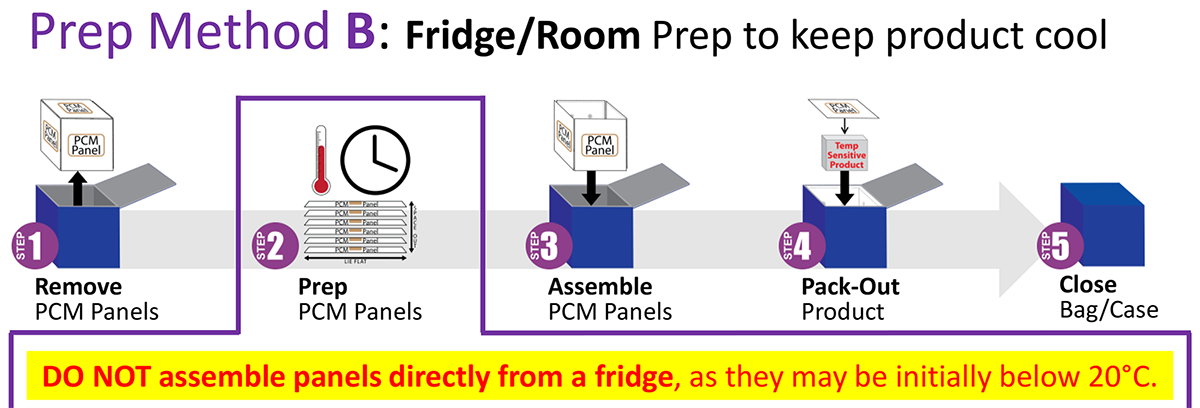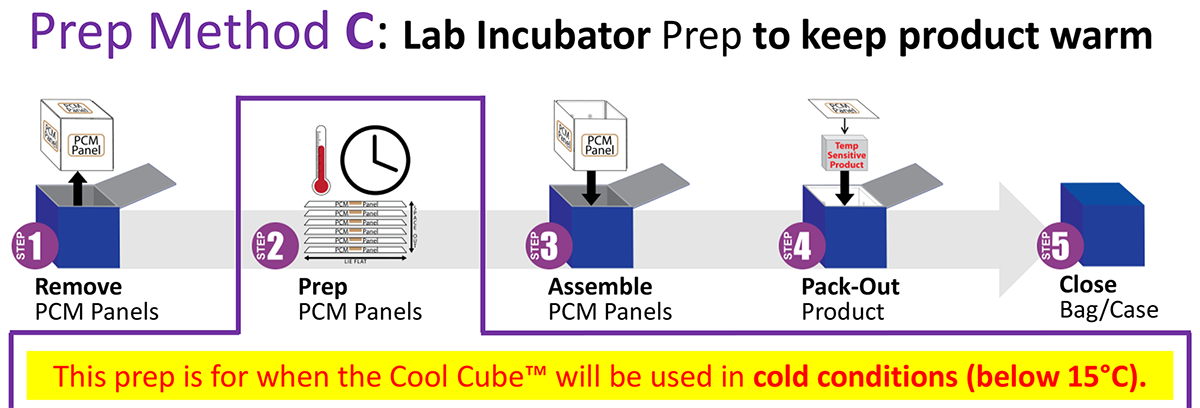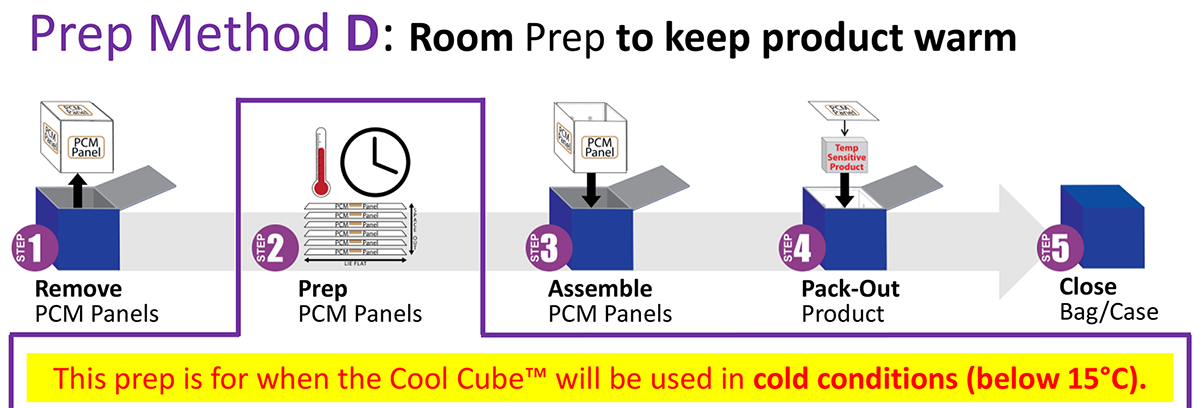Cool Cube™ Room Temp Training Videos
- *Panels may be stored at this stage indefinitely (for longer than indicated).

About Room Temperature PCM (Phase Change Material)
PCM absorbs and releases thermal energy during the process of melting and freezing. When solid PCM melts, it absorbs the heat from the environment, yet its temperature stays at the melting point until totally liquid. Conversely, when liquid PCM freezes, it absorbs the cold from the environment yet stays at its temperature until totally solid. Therefore, PCM an ideal, passive solution for a variety of applications that require temperature control. The most common PCM is water, which has a melting point of 0 °C (32 °F). When solid, ice/water maintains a temperature of 0°C until it turns completely liquid. So, in essence, the 0 °C melting point makes it unsafe for most temperature-sensitive applications.
Cool Cube™ Room Temp PCM has a melting point of 21.5 °C/70.7 °F. When the PCM is solid, a panel helps the Cool Cube™ stay cool (about 22 °C) in hot environments. When the PCM is liquid, a panel helps the Cool Cube™ stay warm (about 21 °C) in cold conditions. It’s right around that 21.5 °C/70.7 °F where a PCM panel’s temperature plateaus for a while during the warming up and/or cooling down processes.
Prep Method A – Lab incubator (prevent warming)

Prep Method A: Lab Incubator Prep to keep product cool
Panel Prep
2.1 Lay panels flat in a lab incubator (or other 15-20°C environment) until all the PCM (phase change material inside the panel) turns solid. At 15°C/59°F the PCM will solidify in a day or two.*
- * If the incubator temperature is ever warmer than 20°C, panels may not get completely solid (manufacturing tolerances). If stored within the temperature parameters of the product, but are still liquid, panels may be used but the hold time will decrease. Although panels are liquid, the PCM inside is at the temperature of storage environment after 3 hours (i.e. stored in a 22°C incubator, the PCM panels are at 22°C). Assembling the Cool Cube™ with this additional thermal mass will keep product at room temperature, just for a shorter amount of time than the lab-validated results.

2.2 Shake panels to verify the PCM is solid. If there is liquid, restart at step 2.1 to ensure the longest hold time. Using liquid PCM or panels with a solid/liquid combination decreases the hold time.
Prep Method B – Refrigerator (prevent warming)

Prep Method B: Fridge/Room Prep to keep product cool
Panel Prep
2.1 Lay panels flat in a refrigerator until all the PCM (phase change material inside the panel) turns solid. At 4°C/39°F the PCM will solidify in a couple hours.
2.2 Spread panels out (enable airflow to all sides) in a room just before use to allow the PCM inside to rise to the appropriate operating temperature. Approximate times:
- “03” size = 35 minutes
- “08” size = 40 minutes
- “28” size = 45 minutes
- “96” size = 50 minutes
- **Times based on a 22°C/72°F room.

2.3 Shake panels to verify the PCM is solid with just a little liquid. If a little liquid is heard, it is at 21.5°C. If there is a lot of liquid, restart at step 2.1 to ensure the longest hold time. Using liquid PCM or panels with a solid/liquid combination decreases the hold time. Wipe off condensate and proceed with assembly.
Prep Method C – Lab incubator (prevent cooling)

Prep Method C: Lab Incubator Prep to keep product warm
Panel Prep
2.1 Place panels in a lab incubator 23-24°C for at least 24 hours before use so the PCM (phase change material inside the panel) is liquid.*
- * Panels may be stored in the fridge until needed for assembly or the PCM solidifies. If an incubator maintains 23°C or above, the PCM within the panels will not get solid (the solidifying point is 21.5°C), keeping the PCM liquid indefinitely until pack-out. Liquid panels will protect the product from getting cold until the PCM inside becomes completely solid.

2.2 Shake panels to verify the PCM is liquid. If they are solid, restart at step 2.1 to ensure the longest hold time. Liquid PCM panels will prevent the product from getting cold (at room temps) in a cold environment the longest. Using solid PCM or panels with a solid/liquid combination decreases the hold time.
Prep Method D – Room temperature (prevent cooling)

Prep Method D: Room Prep to keep product warm
Panel Prep
2.1 Place panels in a room between 23-24°C for at least 24 hours before use so the PCM (phase change material inside the panel) is liquid.*
- * Panels may be stored in a room until needed for assembly or the PCM solidifies. If a room maintains 23°C or above, the PCM within the panels will not get solid (the solidifying point is 21.5°C), keeping the PCM liquid indefinitely until pack-out. Liquid panels will protect the product from getting cold until the PCM inside becomes completely solid.

2.2 Shake panels to verify the PCM is liquid. If they are solid, restart at step 2.1 to ensure the longest hold time. Liquid PCM panels will prevent the product from getting cold (at room temps) in a cold environment the longest. Using solid PCM or panels with a solid/liquid combination decreases the hold time.





You must be logged in to post a comment.